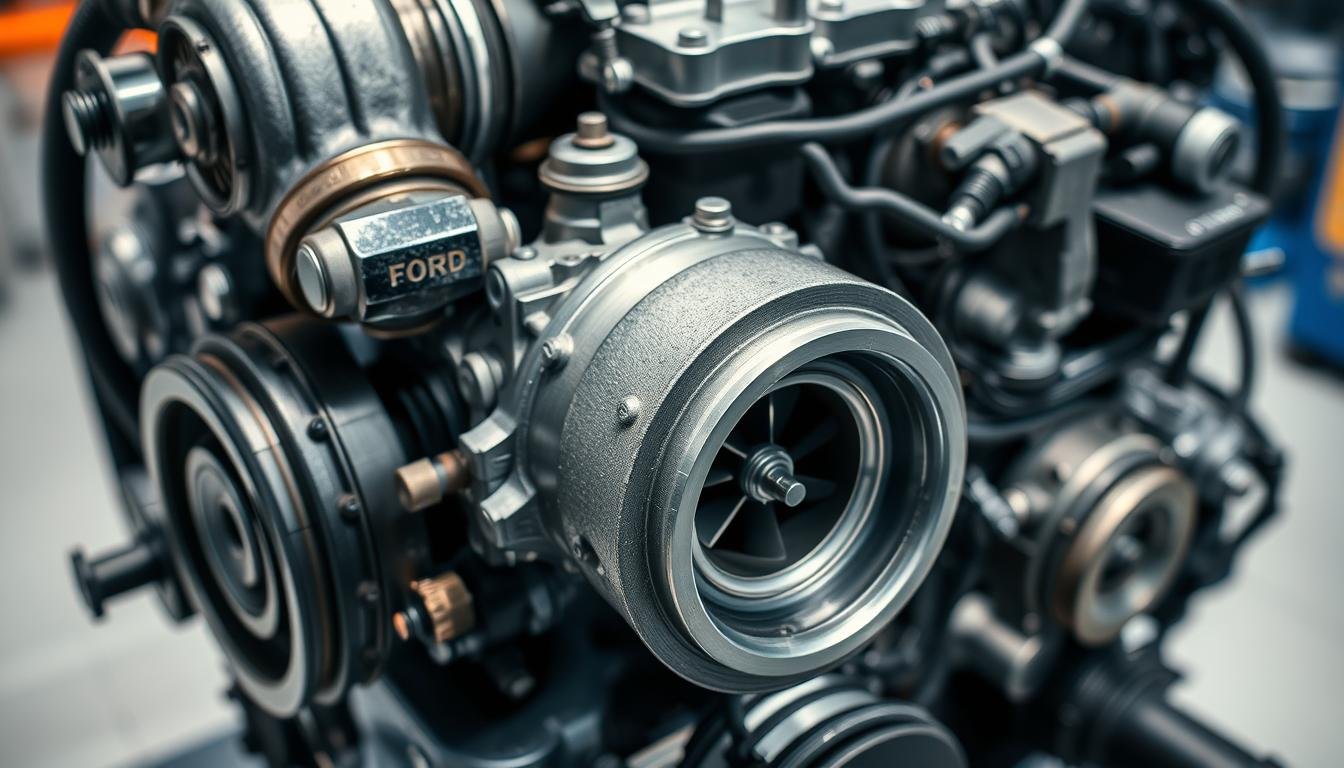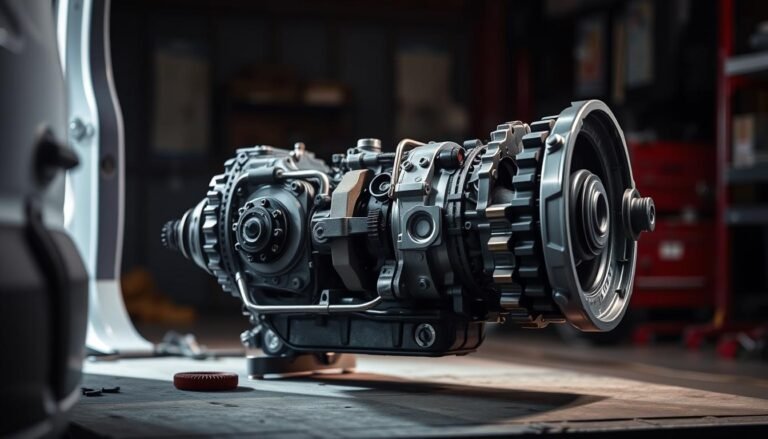Engines Common Issues with Motor 6.7 Ford Diesel Problems
The motor 6.7 Ford diesel can have issues that affect your vehicle’s performance and how long it lasts.
Known for its strength, the 6.7L Power Stroke engine still has problems that owners need to know about.
Despite updates since its 2011 release, some faults with the 6.7 Powerstroke motor are still around. This means owners need to keep up with maintenance.
We will give you essential tips on finding and fixing these issues. This will help your vehicle perform better and last longer.
You’ll learn about common problems like EGR cooler issues, failures of the turbo, and issues with fuel injectors.
Our goal is to give you the knowledge to take good care of your engine. This can save you money on repairs in the future.
By being informed and active, you can make sure your Ford diesel engine runs well for many years.
Introduction To The 6.7L Power Stroke Diesel Engine
The 6.7L Power Stroke diesel engine first appeared in 2011, making waves in the Ford Super Duty lineup.
It’s known for its strong performance, offering great towing capacity and reliability. The 6.7 Powerstroke history is marked by innovation, with technology that boosts power and fuel efficiency.
This engine features cutting-edge turbocharging and an innovative fuel injection system. The benefits of the 6.7 diesel engine go beyond power.
Its high torque ensures smooth operation, even with heavy loads. That’s why truck lovers and those needing solid performance for work or play prefer it.
However, staying alert to potential issues with the 6.7L Power Stroke engine is crucial.
Catching Ford F-series engine problems early helps keep the engine running well for longer. Knowing its strengths and weaknesses helps you get the most out of this engine.
Common Ford 6.7 Diesel Problems
The 6.7L Power Stroke engine is known for its strength and longevity. But it does face certain challenges.
Knowing the common issues with the Ford 6.7 diesel engine helps you be ready for problems you may encounter.
Each problem with the 6.7 diesel can lead to big issues if not fixed quickly.
Overview of Key Issues
Over time, several important parts may start to have problems. Issues reported the most include:
- EGR cooler failures, which can lead to coolant leaks and overheating
- Turbocharger malfunctions that impact boost pressure
- Fuel injector failures, causing poor fuel delivery
- EGT sensor inaccuracies, affecting engine monitoring
- Radiator coolant leaks, leading to engine overheating
- Cracked exhaust manifolds, which can result in exhaust leaks
Impact on Performance
When these parts fail, the overall performance of your Ford diesel engine can be greatly affected. You might notice:
- Loss of power, making it harder to speed up
- Decreased fuel efficiency, which means you’ll spend more on gas
- Increased emissions, which could create issues with laws
If you ignore these diesel issues, severe engine damage could happen. Being proactive keeps your engine working well and efficiently.
| Issue | Symptoms | Long-term Effects |
|---|---|---|
| EGR Cooler Failure | Overheating, coolant leaks | Engine getting too hot, reduced engine life |
| Turbocharger Failure | Loss of boost pressure, whistling noise | Using more fuel, more strain on the engine |
| Fuel Injector Failure | Rough engine idle, slow acceleration | Engine misfires, serious damage |
| EGT Sensor Failure | Wrong readings, engine warnings | Bad tuning, engine getting too hot |
| Coolant Leak | Low coolant level, engine gets too hot | Damaged engine, expensive fixes |
| Exhaust Manifold Crack | Ticking noise, drop in power | More emissions, damage to engine |
EGR Cooler Issues in The 6.7 Ford Diesel
The EGR cooler is key for cutting down nitrogen oxide emissions. It cools down exhaust gases before they go back into the engine.
This part is crucial for a better engine performance and meeting emission rules. But, EGR cooler issues can lead to big performance problems.
Problems with the EGR cooler can show up in several ways. You might see your engine overheating, coolant temperature going up, or white smoke from the exhaust.
These signs mean the cooler is not working right and needs quick action. If ignored, these issues can cause serious engine damage or failure, making repairs expensive.
Checking the EGR cooler regularly is very important. Being proactive helps you catch problems early, reducing the risk of bigger issues later.
If you notice any signs of EGR cooler problems, fixing them fast can prevent costly repairs and downtime.
Symptoms of Diesel Turbo Failure
It’s vital to catch diesel turbo problems early to keep your engine running well. A broken turbo can cause big performance issues if not fixed. Look out for these signs that your turbo might need some work.
Signs of Turbo Problems
- Reduced acceleration: You may feel sluggishness while trying to accelerate.
- Check engine light: The dashboard warning light can indicate various issues, including turbo failure.
- Unusual sounds: Listen for high-pitched whistles or screeches that signal potential turbo problems.
- Smoke from exhaust: Excessive smoke may indicate oil leaks or other related failures.
- Poor fuel efficiency: A drop in fuel economy can signal underlying turbocharger performance issues.
Key Maintenance Tips
To keep your turbo in good shape longer, follow these maintenance tips. They’re especially for maintaining your Ford 6.7 turbo:
- Regular oil changes: Use high-quality engine oils recommended for your vehicle.
- Check air filters: Clean or replace filters periodically to ensure optimal airflow.
- Inspect for leaks: Monitor for any signs of oil leaks that could affect performance.
- Maintain proper boost pressure: Regularly check pressure readings during operation.
- Conduct visual inspections: Routinely examine the turbo components for signs of wear.
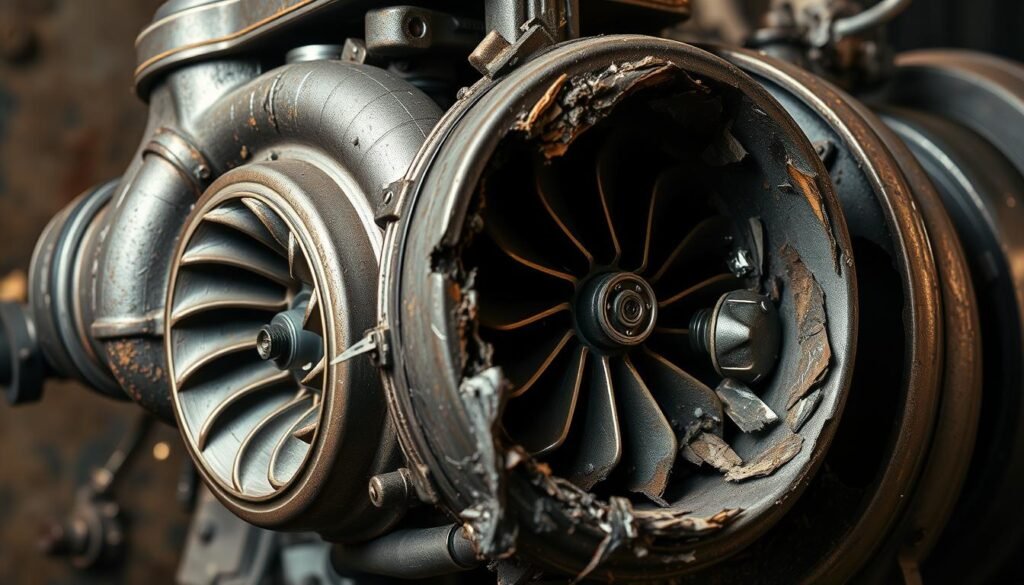
Fuel Injector Failures and Their Causes
Ford 6.7 fuel injector problems are a big worry for diesel engine owners. These injectors play a key role in delivering diesel to your engine’s cylinders.
When they don’t work right, your engine’s performance drops a lot. Injector failures often happen due to clogged injectors.
This can come from bad fuel quality and not taking care of your engine. When dirt gets in the fuel, it can stick to the injector.
This messes up the fuel spray and lowers engine power. Signs of this issue include rough idling, less power, and using more fuel.
It’s important to check your engine regularly to avoid these problems. Using clean, good quality diesel fuel helps prevent injector damage.
Knowing the early signs of trouble helps you fix things before they get worse.
EGT Sensor Failure Signs
The Exhaust Gas Temperature (EGT) sensor is key for checking exhaust temps in your Ford 6.7 diesel engine. If it goes bad, it causes big EGT sensor issues.
These can hurt your engine’s performance and life. It’s vital to spot the Ford 6.7 EGT sensor failure symptoms quickly. This helps avoid worse damage.
Watch out for these common EGT sensor failure signs:
- Dashboard warning lights turning on to alert you of problems.
- Poor fuel efficiency, which means the fuel isn’t burning right.
- The engine acting up, with power going up and down.
When you see these signs, you need to act fast. Getting your engine checked often can find these problems early.
This keeps your engine working well. Ignoring EGT sensor warnings can cause overheating and major engine harm.
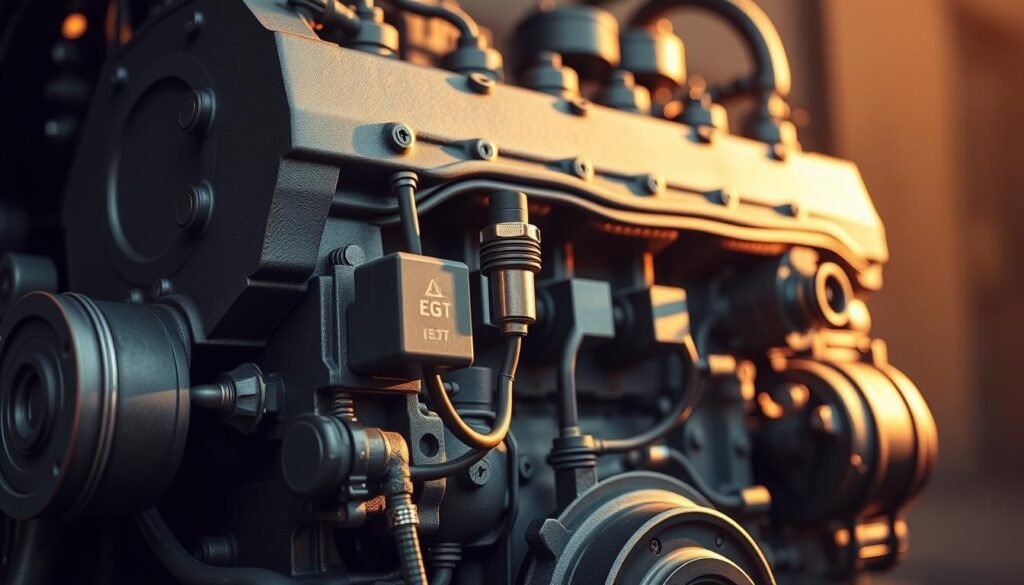
| Symptoms | Description |
|---|---|
| Warning lights | Dashboard alerts indicating potential sensor errors or failures. |
| Decreased fuel efficiency | Unexplained drops in fuel mileage may suggest issues with combustion due to sensor failure. |
| Erratic engine behavior | Fluctuations in power or stability while driving could indicate EGT sensor malfunctions. |
Radiator Coolant Leak Causes
Radiator coolant leaks in Ford diesel engines stem from different issues. These include physical damage, faulty hoses, or loose connections.
Catching these problems early can prevent expensive repairs and keep your engine from getting too hot.
By knowing the usual reasons for these leaks, you can help your engine stay in top shape.
Identifying Coolant Loss
It’s crucial to spot the signs of coolant loss right away. Look out for these clues:
- Noticeable drops in coolant levels in the reservoir.
- Puddles or wet spots under the vehicle, showing leaks.
- Overheating engine during use.
- Green, yellow, or red stains on the ground where the car was parked.
By checking your coolant levels often, you can avoid major overheating problems. This ensures that your Ford diesel runs smoothly.
Cracked Exhaust Manifold Troubles
The exhaust manifold faces extreme temperatures and pressures. Over time, this can lead to cracks. When cracks appear, you might notice some symptoms.
These include weird noises when speeding up and a drop in how well the engine works. This problem can cause big exhaust leaks. It makes your car less efficient.
Ignoring these signs can cause more damage. It can also make repairs cost more. Finding the problem early is key.
It often means you need a new exhaust manifold. Watching for these signs keeps your car running well. It saves you both time and money.
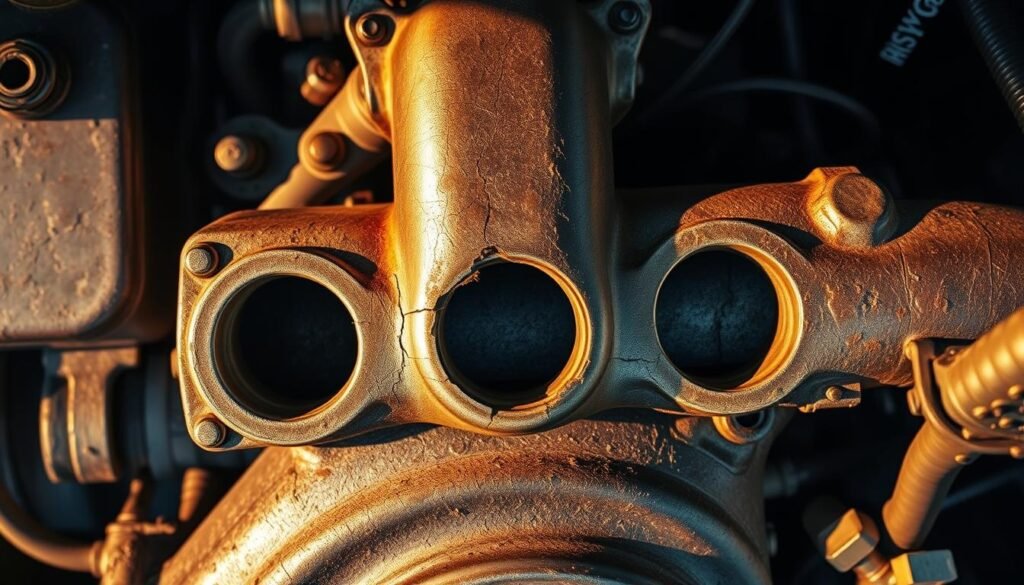
| Symptom | Description |
|---|---|
| Strange Noises | Unusual sounds during acceleration, indicating exhaust leaks. |
| Decreased Performance | Noticeable loss of power and efficiency while driving. |
| Exhaust Odor | Pungent smell of exhaust gases entering the cabin. |
| Check Engine Light | Engine diagnostics may indicate manifold issues. |
| Heat Damage | Visible cracks or discoloration around the manifold. |
Additional Common Issues with The Motor 6.7 Ford Diesel Problems
It’s important to know the range of problems with the 6.7 Ford diesel engine. This helps keep it running well.
Besides common troubles, there are other issues that can hurt the engine’s health and life. Fixing these problems quickly can stop severe damage.
Cumulative Effects on Engine Health
The 6.7 Ford diesel engine has a lot of problems. Bad CP4 injection pumps can mess up fuel delivery. This affects how well the engine runs.
Ruptures in the cold side charge pipe can also cause a big loss of boost pressure. This makes the engine less efficient.
Each problem with the Ford 6.7 adds up and can make the engine perform worse. Not fixing them quickly can lead to bigger engine troubles.
Checking the engine regularly and carefully is key to catching these extra problems early.
Look out for signs like weak acceleration and using too much fuel. Fixing issues early can save you a lot of money later on.
Preventative Maintenance Tips For 6.7 Power Stroke Owners
For those who own a Ford 6.7 Power Stroke, it’s super important to follow good maintenance tips. Keeping a close eye on your vehicle’s essential parts can catch problems early.
This means you can fix things before they get worse, saving money and keeping your vehicle running well.
Regular Inspection Techniques
Setting up a monthly check-up for your vehicle is smart. You should pay attention to:
- Coolant levels: Check for proper levels to prevent overheating.
- EGR cooler status: Inspect for leaks or blockages that can affect performance.
- Turbo performance: Listen for unusual sounds that may indicate issues.
Having a checklist makes these checks easier. This way, you won’t miss anything important.
Effective Maintenance Schedules
Creating a solid maintenance plan is key for your Ford 6.7. Make sure to include:
- Regular oil changes: Essential for lubricating engine components and maintaining efficiency.
- Filter replacements: Replace air, fuel, and oil filters to ensure optimal engine performance.
- Coolant checks: Flushing and replacing coolant when necessary will keep things running smoothly.
Write down all your service dates to keep track of your vehicle’s health. By doing these maintenance tasks, you can avoid bigger repairs later on.

Troubleshooting Ford 6.7 Diesel Motor Issues
When dealing with Ford 6.7 diesel motor issues, it’s key to have a clear plan. You should start by reading error codes with diagnostic tools.
These codes reveal specific problems and make diagnosing easier. It’s important to identify signs of trouble in your engine.
Listen for odd sounds and check if there’s a drop in performance. Noticing warning lights is also crucial. These signs help narrow down possible issues.
Make a thorough checklist of potential problems. Write down any symptoms and error codes.
This information is valuable for a quick and accurate diagnosis:
- Use OBD-II scanners to find error codes.
- Look over wiring and connections for any damage.
- Check the fuel system’s pressure.
- Inspect the EGR system and turbocharger for any issues.
- Check the exhaust for any strange emissions.
Following these steps carefully ensures nothing is missed. Every step brings you closer to understanding the issue. This approach saves both time and effort.
Cost Implications of Repairing Ford Diesel Engine Problems
Grasping the costs of Ford diesel engine repair is vital for your budget. Issues like turbocharger replacement and EGR cooler repairs can be pricey.
It’s key to understand these costs to avoid financial surprises with Ford 6.7 fixes.
The table below shows average repair costs for common Ford 6.7 diesel engine issues. This info will help you budget wisely.
| Repair Type | Average Cost |
|---|---|
| Turbocharger Replacement | $2,500 – $3,500 |
| EGR Cooler Replacement | $1,200 – $1,800 |
| Fuel Injector Replacement | $1,000 – $1,500 |
| Exhaust Manifold Repair | $800 – $1,200 |
| Radiator Repair | $500 – $900 |
With these costs in mind, you can plan better. Save for these repairs to keep your vehicle running smoothly without financial stress.
Conclusion
The 6.7 Ford diesel engine is powerful and reliable, but it has some issues that need attention. Common problems include EGR cooler failures and fuel injector issues.
Spotting these problems early can save you from big repair costs later. Keeping up with regular maintenance and inspections is crucial.
Doing this keeps your engine running well and can save you money in the long run. It’s key to keeping your vehicle dependable.
Knowing how to deal with the 6.7L Power Stroke diesel engine’s challenges is important.
Taking care of your engine today means it will run smoothly for many years. Your efforts will pay off by keeping your engine healthy and efficient.
FAQs
Q: What are the most common problems with the Ford 6.7L Power Stroke diesel engine?
A: The Ford 6.7L Power Stroke diesel engine often faces issues. These include EGR cooler failures and turbocharger problems. Also, fuel injector malfunctions, EGT sensor failures, coolant leaks, and cracked exhaust manifolds are common. Regular maintenance is vital to prevent these problems from affecting performance.
Q: How can I identify signs of EGR cooler failure in my 6.7 Ford diesel?
A: Signs of EGR cooler failure are noticeable. Look for engine overheating, white smoke, and odd exhaust odors. It’s crucial to fix EGR cooler issues quickly to avoid engine damage.
Q: What are the early signs of turbo failure in the 6.7 Power Stroke engine?
A: Early symptoms of turbo failure are clear. These include loss of acceleration, the check engine light, and strange noises. Catching these signs early helps keep your engine running well and cuts repair costs.
Q: Why are fuel injectors critical for the 6.7 diesel engine’s performance?
A: Fuel injectors play a key role in managing diesel flow into the engine. Clogs from bad fuel quality can lead to idling issues and more fuel use. Regular checks help avoid these problems.
Q: What can cause EGT sensor failure, and how can it be detected?
A: Warning lights, lower fuel efficiency, and irregular engine behavior are signs of EGT sensor failure. It’s important to fix or replace it quickly to prevent more engine trouble.
Q: How can I detect coolant leaks in my Ford 6.7 diesel engine?
A: To spot coolant leaks, watch for dropping coolant levels and puddles under your vehicle. Also, check for overheating. Regular checks help keep the engine cool and prevent major damage.
Q: What preventative maintenance should I perform on my 6.7 Power Stroke engine?
A: Keep your engine in top shape with regular oil changes and air filter replacements. Also, check coolant and inspect vital parts often. A good maintenance schedule helps your engine last longer and perform better.
Q: What are the average repair costs for fixing common Ford 6.7 diesel engine issues?
A: Repairing a Ford 6.7 diesel engine can cost. On average, expect to pay

